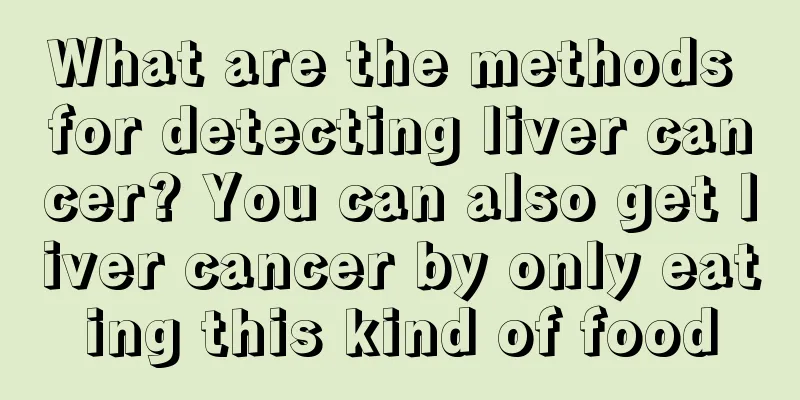What are the methods for detecting liver cancer? You can also get liver cancer by only eating this kind of food

|
The cause of liver cancer is usually called "poisoning". Since the liver is the main detoxification organ, the chance of liver cancer is higher than other cancers. The early symptoms of liver cancer are relatively hidden and easy to ignore, so it is important to correctly understand the cause of liver cancer and do daily prevention. Some people think that only those who eat a lot of meat and fish all day can get fatty liver, so sticking to a vegetarian diet can keep liver cancer away. However, in fact, it is not only people with excess nutrition, people who often eat greasy food, and people with malnutrition who are also common in the fatty liver. People who lack exercise, especially women with a cold body, plus the lack of necessary exercise, will lead to insufficient blood flow, reduced liver metabolism, and inability to detoxify in time, leading to liver disease. What factors are likely to cause liver cancer? 1. Viral hepatitis Among the known hepatitis viruses, all except hepatitis A virus are associated with liver cancer. Hepatitis B virus (HBV) is the main cause in developing countries, while hepatitis C virus (HCV) is the main cause in developed countries. Chronic HBV infection increases the risk of liver cancer by 200 times. 2. Eating food contaminated with aflatoxin and its mycotoxin A large number of investigations and studies have found that the distribution of aflatoxin contamination is almost consistent with the geographical distribution of liver cancer high-incidence areas. After these contaminated foods are ingested, they are absorbed into the liver, causing liver cell degeneration and necrosis, and then inducing liver cancer. Foods that are prone to mold include rice, wheat, soybeans, peanuts, corn, rapeseed oil, etc. 3. Drinking Drinking has a significant and independent effect on the occurrence of liver cancer, and it shows a significant dose-effect relationship. It is generally believed that excessive drinking often leads to liver cancer through fatty liver, alcoholic hepatitis and cirrhosis. Among alcoholic cirrhosis, 10% to 30% develop liver cancer. 4. Water Source Pollution The contamination of drinking water by certain chemical carcinogens and certain algae is also related to the occurrence of liver cancer. More than 100 carcinogenic or cancer-promoting substances have been found in polluted water. 5. Chemical carcinogens Some chemical substances such as nitrosamines, azo mustards, alcohol, organochlorine pesticides, etc. are carcinogens of liver cancer. Among them, N-nitroso compounds are the main ones. Animal experiments have found that dimethylnitrosamine and 3-nitroaniline can induce liver cancer. 6. Disease Factors Studies have found that some diseases can increase the risk of liver cancer, such as diabetes, esophageal varices, cirrhosis, obesity, fatty liver, hereditary hemochromatosis, and hereditary telangiectasia. 7. Genetic factors Liver cancer has obvious familial aggregation and genetic susceptibility. The number of people with liver cancer in families with blood relations to liver cancer cases is much higher than that in unrelated families, and the number of people with liver cancer in close relatives is higher than that in distant relatives. 8. Nutritional factors The intake of vegetables and fruits can reduce the risk of cancer. Studies have also found that drinking coffee is associated with a lower incidence of liver cancer, and there is a dose-effect relationship. Regular coffee drinking is a protective factor for liver cancer. IX. Immune status Some people believe that the plasma of liver cancer patients contains a blocking factor that can inhibit cellular immunity and protect liver cancer cells from being killed by immune cells. It has been proven that alpha-fetoprotein (AFp) produced by liver cancer has this effect. 10. Other factors Studies have shown that long-term oral contraceptive use can increase the risk of hepatic adenoma and may also increase the risk of liver cancer. What are the methods for detecting liver cancer? 1. Ultrasound examination: Ultrasound examination is economical and convenient, and can show the size, shape and location of the tumor. 2. Ultrasound angiography: In terms of the diagnosis of the number of liver tumors, ultrasound angiography has more advantages, such as good safety, no allergic reactions, and relatively low examination costs. 3. Enhanced CT: Compared with ordinary CT, enhanced CT has a high ability to identify lesions and can improve the accuracy of tumor staging. It has diagnostic advantages for hepatobiliary lesions such as liver cancer, common bile duct lesions, hepatic hemangioma and bile duct. 4. Magnetic resonance imaging: This examination has developed rapidly in recent years and can make relatively accurate judgments on some small lesions in the liver. 5. Celiac artery or hepatic artery angiography: This is an invasive examination with a higher detection rate for smaller cancers that are rich in blood vessels. 6. Alpha-fetoprotein test: When ultrasound or CT scans and other imaging tests suspect early liver cancer, an alpha-fetoprotein test is generally recommended to assist in diagnosis. |
Recommend
Cure rate of mid- to late-stage testicular cancer
Testicular cancer is a malignant tumor that occur...
What are the hazards of wrist laser therapy device?
In daily life, wristwatch laser therapy device is...
Tips to prevent chronic pharyngitis in summer
During the dog days of summer, when the temperatu...
8 indispensable steps to prevent computer radiation
Do you know the correct way to prevent computer r...
Is duck meat a hairy food?
There are many foods in the world that are irrita...
Can taking calcium tablets help you grow taller at the age of 22
I believe everyone wants to be taller, which make...
Can tea oil reduce swelling?
Tea oil is a common substance in our daily life. ...
Does mutton cause internal heat? Who is not suitable to eat it?
Mutton is a very common food ingredient, suitable...
How to discharge residual milk two years after weaning
After the mother has breastfed the fetus for a ce...
Is excessive sweating caused by kidney deficiency?
People who sweat too much need to consider whethe...
How to take care of your skin after sunburn?
When the sun is very strong, if you go outdoors w...
What medicine should I take for conservative treatment of advanced bile duct cancer
Emotional factors are very important for the deve...
What are the symptoms of gastric reflux?
I believe that everyone will encounter situations...
Do you know the effects of niacinamide on the skin?
Having fair and tender skin is the dream of every...
Sudden weight loss! Beware of sub-health
Health doctors say that sub-health receives relat...









